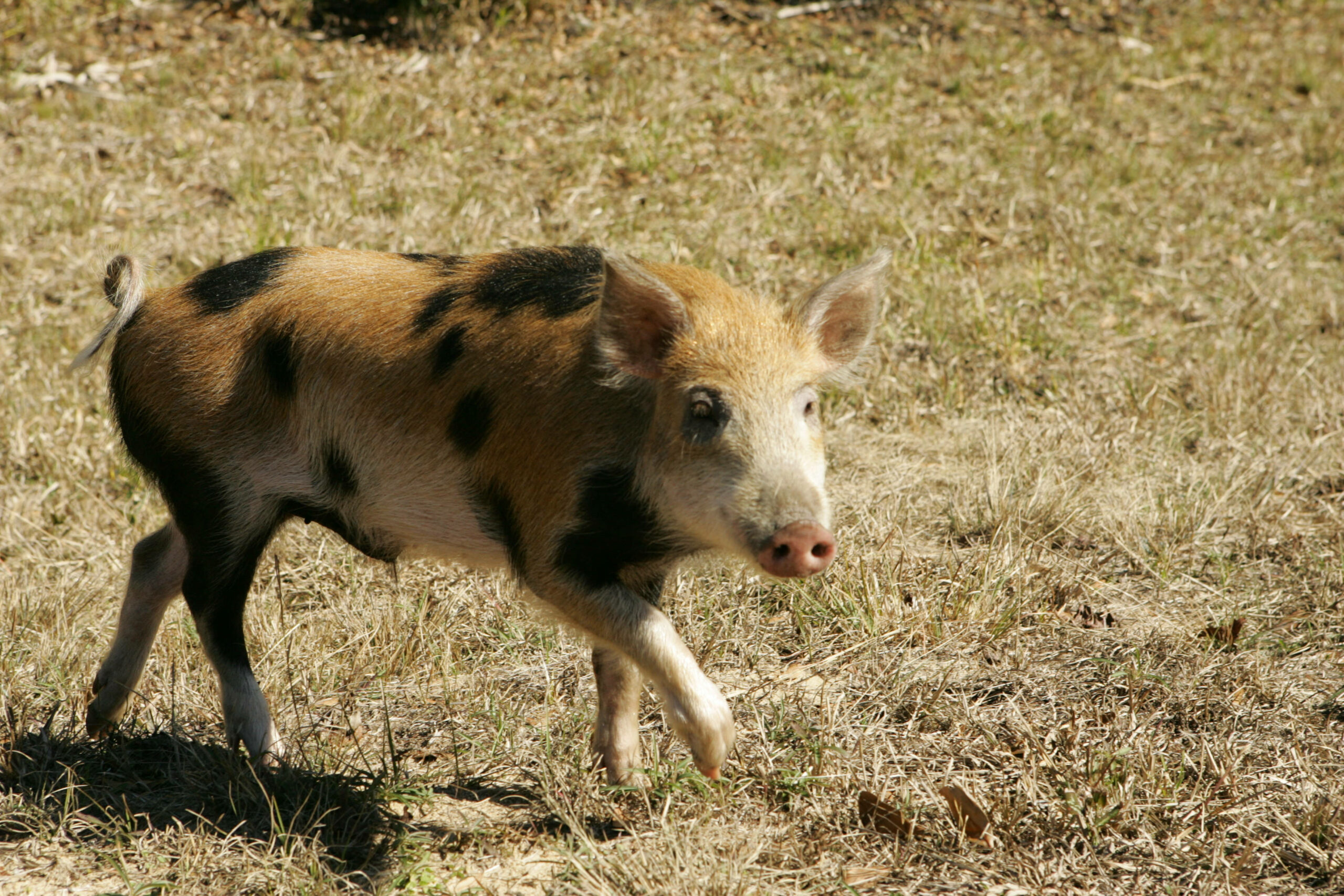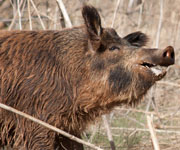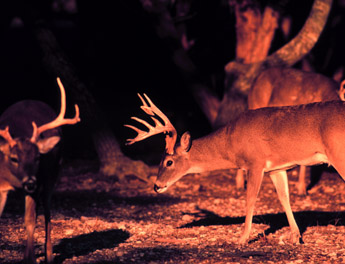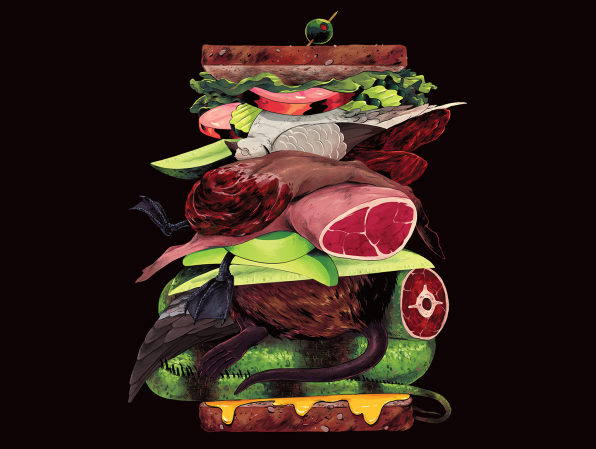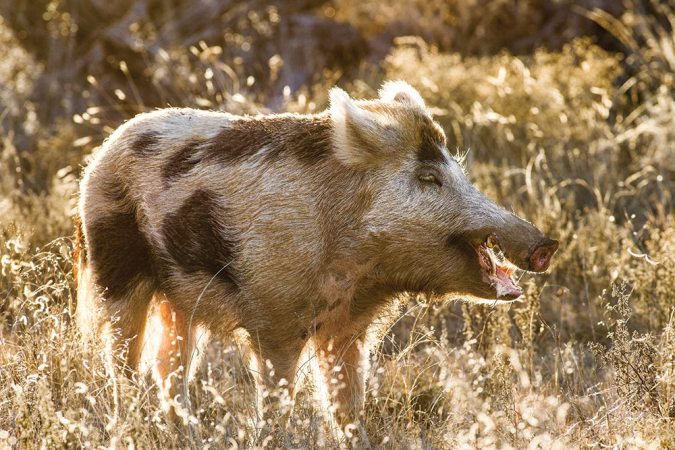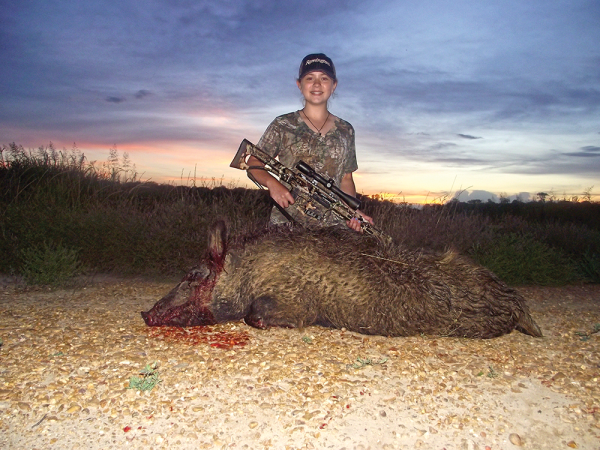When I belonged to the Panhandle Bowhunters Association in Pensacola, each year a bunch of us would gather at St. Vincent Island NWR in Apalachicola Bay to hunt whitetails and wild hogs. Mainly, we hunted the latter and ate a lot of oysters. The island was overrun with feral hogs, and it wasn’t much trouble for a bowhunter to shoot at least one or two during a three-day hunt.
The U.S. Fish and Wildlife Service, which managed the island, would have been glad if we had killed every hog there. They had surpassed the status of being annoying and were regarded as public nuisance number one. That general opinion of feral swine has not diminished over time, and if anything has expanded in range. Wild hogs are the worst four-legged pests to ever invade the South and they’ll eat anything, including crops and the young of various game birds and animals.
Throughout the region, feral hog management has evolved into feral hog containment. For one thing, hogs are prolific breeders and live in places that typically aren’t easy to get into. They also can be difficult to approach; any animal with a nose as big as a quart jar and ears the size of a catalpa tree leaf isn’t likely to be a pushover. Consequently, there’s been a pig boom and it’s led to relaxed hunting restrictions. On private land they’ve been relaxed to the point of being non-existent. Most landowners, be they farmers or paper companies, will allow hunters on their property and usually all it takes is a written and signed permit.
There’s a lot of free private land available and you can check the Internet for clues. The first sites to visit are those of game and fish departments, agricultural departments, state farm bureaus and state soil conservation services. These folks hear complaints about feral hogs from landowners and farmers all the time, and might be the gateway to a great hog hunt in early fall.
Where to Hunt for Your Trophy Wild Boar
On private or public land, the opportunities to go after a tusker trophy to hang over the door, or just to stock up on the other white meat, are abundant. Below are some Southern states you might want to explore. Remember, wherever there is a wildlife management area or national wildlife refuge with the porcine predators running wild, there are private lands surrounding them whose owners likely will welcome respectful hunters.
Target Pigs in Alabama
There are currently 17 wildlife management areas that support hog hunting. In southwest Alabama, the best opportunities are found in the Upper Delta, Mobile-Tensaw Delta, and the W.L. Holland wildlife management areas. Scotch, Frank W. and Rob M. Boykin WMAs have smaller populations. Southeast Alabama has small hog populations on Blue Springs and Covington WMAs. Farther north, try Lowndes WMA south of Montgomery. Freedom Hills, Seven-mile Island, and the Black Warrior WMAs are tops in the northwest corner of the state. In the northeast, check out James D. Martin-Skyline, Little River and Choccolocco WMAs. Visit outdooralabama.com for more info.
Hunt Wild Boar for Free in Florida
Thanks to the original seed stock brought into Florida by the Spanish explorers, the state has more feral hogs than it knows what to do with. Wild hogs can be hunted year-round on private land and there is no limit on how many you can take. On wildlife management areas, hunting hogs is restricted to certain dates and seasons. The Apalachicola Wildlife Management Area (564,000 acres) in Franklin, Leon, Liberty, and Wakulla counties is part of the vast Apalachicola National Forest and offers good hog hunting. The Apalachicola Bradwell Unit (1,420 acres) along the Ochlockonee River hosts old-fashioned Hog Management Dog Hunts and Hog Management Still Hunts on select weekends from May through September. These require a quota-hunt permit. Aucilla WMA in Jefferson and Taylor counties is another popular destination. There are millions of acres of public hunting land in Florida and virtually any wildlife management area, federally managed land, or paper company land have at least fair numbers of wild hogs. Visit myfwc.com for more info.
Bowhunt for Boar in Georgia
If you have a landowner’s permission to hunt hogs, you can go after them at night with a spotlight or hunt them over bait with just about any type of firearm or archery equipment. If you’re from out-of-state, a non-resident license is required, but otherwise it’s pretty much no holds barred. On state or national forests, as well as WMAs, the rules are more restrictive, but still favor the hunter. During special seasons, firearms and archery equipment used to take hogs must correspond to the regulations.
There are dozens of WMAs that support good hog hunting, and most of them are in the southern half of the state around the major river bottoms such as the Chattahoochee, Oconee, Flint and Ocmulgee. Big Hammock, River Bend and Beaverdam WMAs, as well as those in the delta areas of the southeast coast such as Altamaha, Paulks Pasture and Clayhole Swamp are all good. Private holdings around the Okefenokee National Wildlife Refuge and anywhere on both sides of the Georgia-Florida state lines are apt to have a lot of hogs too. Visit eregulations.com for more info.
Hunt Bacon for Free in Oklahoma
The Honobia-Three Rivers WMA that encompasses the Upper Mountain Fork, Glover, and Eagle Fork rivers in the southeastern corner of the state is open to the public. Its 930,000 acres (within the Ouachita National Forest, plus some timber company land) are home to lots of wild hogs. Permits are $85 for nonresidents.
Hunters don’t need a license to hunt feral hogs on private land most of the time, but if they hunt hogs during a big-game season, they need the license for that particular season. Feral hogs have gotten to be such a problem in Oklahoma that the state’s Department of Agriculture maintains a directory of hunters and trappers that landowners can contact to rid them of the nuisances. Chances are any farmer with hog troubles will let you hunt for free. Visit odwc.ok.gov for more info.
Target Hogs Down in Tennessee
Originally, Russian boars (and, of course, sows) were released as game animals on private land in a few counties in the eastern part of the state. Today, 80 of the 95 counties have wild hogs, most of them good old-fashioned Durocs, Hampshires, Poland Chinas, and the like that have gone bad. They wore out their welcome in 2011, when they lost their lofty status as game animals. Feral hogs range from the swamplands around Reelfoot Lake, to the bottomlands of the Mississippi, to Land Between the Lakes, to the Tennessee River valley, and eastward to the Smoky Mountains. Farmers are granted a lot of leeway to get rid of hogs on their property, including allowing “designees” to help them. Wild hogs can be taken on any wildlife management area during deer season, or year-round on private land. Visit tn.gov for more info.
Hunt Pigs in South Carolina
Folks in the Palmetto State know what to do with wild hogs—they barbecue them and have a pig pickin’. Feral hogs are present in every county of the state and it’s pretty much unregulated as far as hunting them. You can hunt wild hogs year-round on private land, day or night (permits required for centerfire rifle or shotgun), and there are no limits. Any of the wildlife management areas in or adjacent to the Low Country counties have plenty of hogs, as do inland WMAs along major rivers such as the Pee Dee and the Congaree. Portions of the Francis Marion National Forest are also choice. Visit dnr.sc.gov for more info.
Free Hog Hunting on Public Land in Texas
By far, the Lone Star State has more feral hogs than any other state. That doesn’t mean they’re free and easy for most hunters, however. Ranches and other private lands overrun with hogs—especially in the southern part of the state—are typically reserved for fee hunting. If you’re close to croplands in the major river valleys such as the Canadian, Sabine, and the Red, ask a farmer for access. You have to have a valid hunting license, but otherwise there’s no closed season or bag limits. Hog hunters are usually welcome in such north Texas counties of Briscoe, Childress, Cottle, Hall, and Motley. Otherwise, try wildlife management areas such as Matador WMA in Cottle County and Caddo Lakes WMA in Marion and Harrison counties. Walk-in hunts administered by Texas Parks & Wildlife are other options. Visit tpwd.state.tx.us for more info.
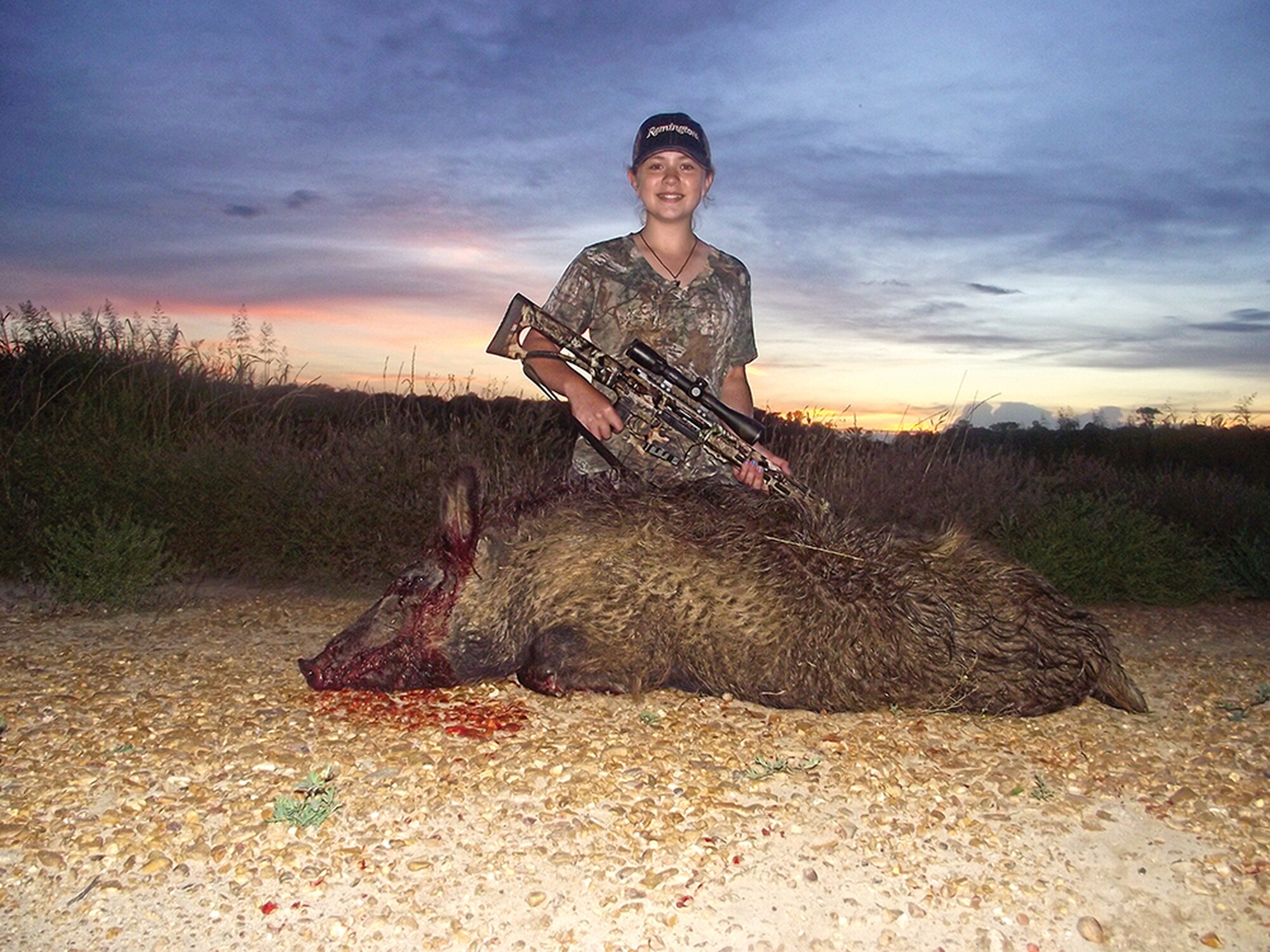
Ask Permission to Hunt For Your Bacon On Private Land
“Here, hold my Red Bull and watch this.”
Guide Scott Bell first grinned, then aimed his truck at the sizable ditch dividing our north Texas field in two. On one side was us, perched in a pickup; on the other, a sounder of feral hogs hauling piggy-tail away. I added his can to our collection of energy drink and pop cans and braced myself as we took flight—literally.
Both Bell and I let loose with “hell yeahs!” as the pickup cleared the ditch—barely—slamming back to earth with a metallic groan. From there, it happened fast—the truck came to a halt, we slid from the cab, and it was on. I shouldered my Remington R25 GII and aimed, enjoying the range and cutting petals of the Remington .308 Win., 168-grain Hog Hammer rounds. Time to make bacon, Texas-style.
Hogs are an introduced, invasive species. Most experts say our hogs are descended from Spanish pigs brought to Florida and the Gulf Coast shores in the 1600s. Destroying farmers’ livelihoods by eating crops and rooting up land is their favorite pastime; hunting them helps farmers. It also strengthens your current skills and adds new ones.
Understand Your Local Pigs
Familiarizing yourself with hog anatomy before you hunt is essential. Hogs are low riders, with shoulders higher than their hips. Their hide is tough, and boars have dense mantles of cartilage over their shoulders. That is meant to protect against challengers’ tusks, but it also provides armored protection from bullets. Their shoulders are shorter than those of deer, meaning their vitals are positioned lower.
A hog’s heart sits low in its chest and slightly forward of the lungs. What would be a lung shot on a deer is a gut shot on a hog, and hogs are capable of surviving such an injury. To hit the heart, aim behind and slightly above the hog’s elbow. Lungs are higher; shoot too high, and you hit the shoulder. Some hunters purposely break the hogs’ shoulders, but that often does not result in the quickest kill. Shooting right behind the ear is another option—something many outfitters suggest since it requires less accuracy than a heart shot.
A clean kill is the ethical responsibility of every hunter, so make sure your shot delivers.
Arm Yourself With The Right Rifle
Hogs can be hunted with almost anything, depending on the state. The .223 Remington is the most popular rifle caliber, but I’ve hunted them with everything from 10mm to .308 Win. to .338 Lapua Magnum. Ammunition matters; rounds like Hornady Full Boar or Remington Hog Hammer ensure penetration and expansion despite those tough hides.
Bows may also be used, and some states allow knives.
Be a Tactician
Hunting methods differ by state, but in many places, options are seemingly endless, including spot-and-stalk or hunting from blinds and extending to baiting, night hunting, and spotlighting.
Hogs dislike heat, so hunt them at first and last light during warmer months. When it’s hot, hunt over water and shady, muddy spots. Be prepared to fire.
When you flush a hog, he might come at you rather than run away. And remember, hogs may not have good vision but they have a keen sense of smell. They’ll wind you in a heartbeat.
Find the Sweet Spot
As with any game, taking hogs on public land is challenging but not impossible. Talking to local farmers is also worthwhile. “Hogs cost us thousands of dollars in replanting costs,” says farmer Jay Coleman. “They reproduce fast, and it’s a job trying to keep them under control.”
He allows trusted hunters on his Mississippi property, and he’s not the only farmer to do so. If you ask permission and follow the rules, you’ll be welcomed. Outfitters are an option as well. Scott Bell works at the 91,000-acre Spike Box Ranch in Benjamin, Texas.
“Deer hunting is okay, but limited. With hogs, there’s no bag limit. One day in May, we took a couple of groups out and bagged 70 pigs total,” Bell says. “It’s a rush!” Free-range ranches like the Spike Box are the way to go. Hogs there vary from 60-pounders to 350 pounds of bacon on the hoof.
Properties like it have put me on everything from spot-and-stalks with night vision to 1,000-yard shots with a .338 Lapua Magnum—and a freezer full of meat.
